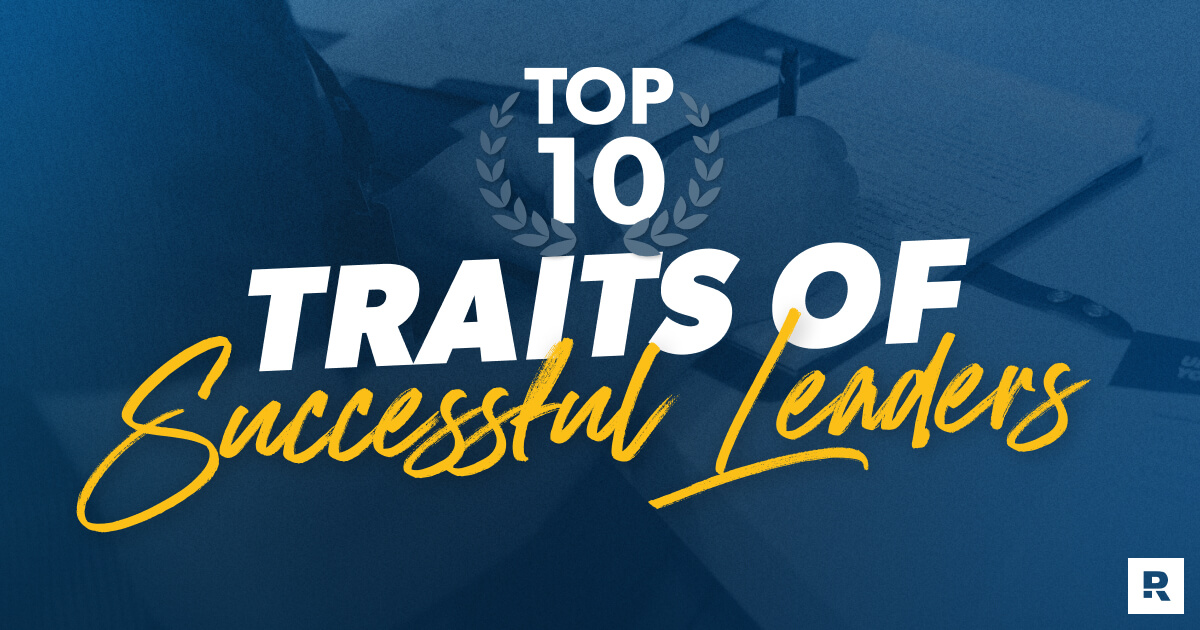Leadership Traits and Tips to Help You Become a Successful Leader
10 Min Read | Nov 7, 2024

Most days, you might feel more like a firefighter than a business owner—meaning you spend all your time at work running around and putting out fires. You’ve got your nose to the grindstone, your hand to the firehose, and just about every other part of you stretched.
We get it. You can be so focused on what’s urgent—making payroll and staying staffed—that you’ve got no time left for other important things. But the truth is: If you want to grow as a leader and build something freaking amazing, you have to put leadership development at the top of your to-do list (yes, it’s that important).
How do you start developing as a leader? A solid understanding of good and bad leadership traits will help you get real about your own strengths and weaknesses. So, let’s talk about what leadership traits are and how successful business leaders use them to build and empower their teams.
What Are Leadership Traits?
Before we dive into leadership traits, we need to clearly define leadership. Leadership is the ability to influence and maximize the talents, passions and skills of others to achieve a goal. Leadership traits are the characteristics you tap into that help you empower others. Good leaders don’t develop these positive characteristics just so they can reach their personal goals or get a pat on the back. They work on themselves so they can bring out the best in their teams, help their customers, and make a bigger impact on the world.
You probably thought running a business sounded fun—until you realized it would actually run you. Discover the EntreLeadership System—the small-business road map that takes the guesswork out of growth.
Related article: What Is Leadership?
Free EntreLeadership Reading Guide
What should EntreLeaders read? We've got our list of book recommendations, with 100 book titles on topics like hiring, business strategy, sales, leadership and more!
What Are the Top 10 Leadership Traits of Successful Leaders?
With all that in mind, let’s dig into the top 10 traits of quality leaders. You’ll find some characteristics you naturally rock at and others you need to work on. But that’s the point—successful leaders work at winning. So roll up your sleeves, and let’s get to it!
1. Integrity
We’re talking fanatical integrity—no lying, cheating or stealing, and no tolerating those behaviors on your team either. You prioritize character over skill, do what you say you’ll do, and aim for excellence—even in ordinary tasks. Notice we didn’t say you’re perfect. The pressure of perfect kills momentum quick. Leaders with integrity are simply great people doing great work, and they expect the same from team members.
2. Servant-Heartedness
The secret to living a fulfilled life isn’t about getting more. It’s about living generously. When you serve others, you give your time, talent and resources to your team, customers and community. And here’s the fruit of that: They’ll repay you with loyalty in ways that keep you and your business growing.
Related article: What Is Servant Leadership?
3. Humility
You can have all the education, experience and intelligence in the world, but if you’re constantly bragging about your accomplishments rather than sharing the praise with others, you’re on a path to self-destruction. Remember in grade school when no one wanted to pass the ball to the ball hog or jerk? It’s the same in business. No one wants to work with a know-it-all. Be confident, but leave pride and arrogance at the door.
4. Vision
When you’re a visionary, you think big and then show your team where you’re headed so you can do big things together. As your team catches hold of your vision and believes they’re doing work that matters, they’ll be more satisfied, productive and empowered.
Related article: Vision Casting: 7 Reasons Why It Matters
5. Decisiveness
Indecision and leadership don’t work together. As a decisive leader, you get the details and facts you need to make up your mind and then lead with clarity and courage. If you get new information and need to change course later, that’s okay. Don’t be afraid to fine-tune your decision or make a new one if things change. That’s called learning and growing.
Related article: How to Improve Your Decision-Making Skills
6. Discipline
Discipline is tied to intentionality—meaning you use your time, words and routines carefully and thoughtfully. That talk earlier about urgent and important things? Yep, discipline is what keeps you focused on the right priorities. Disciplined leaders make a plan and stick to it. They set clear goals and chase them like a tiger, and they refuse to give in to challenges.
7. Passion
When you know your purpose and keep it in front of you, you live with a healthy drive for excellence and a desire to reach as many people as you can. You play to win and live by the belief that “luck” comes dressed in work clothes.
8. Loyalty
You see people as your greatest investment and treat them the way you want to be treated—with care and consistency. Just like being servant hearted produces loyalty from your team and customers, so does loyalty.
9. Attentiveness
Want to be known as a better communicator? Be a better listener. After all, God gave you two ears and just one mouth for a reason. Great leaders ask thoughtful questions and make a point of listening to the answers. That’s when you hear the wins and struggles of your team and customers and you’re more open to new ideas that move your business forward. Listening is also a good way to hear about your strengths and blind spots.
Related article: How to Communicate Effectively
10. Influence
Influential leaders lead with substance, communicate clearly, and help their team members win. People are drawn to you when you’re genuine, charismatic and persuasive. As your team learns to trust you, they—and your business—will get even stronger!
What Are Some Bad Leadership Traits?
Before you get to work developing your leadership, let’s take a quick detour. Here’s a list of some bad leadership qualities that will give you a clear picture of dangers to avoid.
- Poor financial management and being in debt
- Lack of integrity
- Fears risk and change
- Bad at communication
- Poor at decision-making
- Lacks knowledge and skill in the field they’re in
- Fails to build a strong team around them
- Lacks understanding and concern for their team and customers
- Passes the buck rather than taking responsibility
Words of Wisdom From 8 Top Leaders
Okay, enough about the dark side. We promised you’d get wisdom and tips from some inspiring business leaders and entrepreneurs who are crushing it. Take a look at how the passion, drive, integrity and other characteristics of these quality leaders have shaped their influence and success.
1. Dolly Parton, country music artist and businessperson
Live and lead with integrity.
“Sometimes you really have to work with people in order to get where you’re needing to go. But always . . . keep your principles and your values intact.” Dolly also encourages leaders and entrepreneurs to stay humble and grateful, work hard, and generously give your time and resources to others.
2. Dave Ramsey, CEO of Ramsey Solutions and bestselling author
People matter most.
"Your customers aren’t units of revenue. Your team members aren’t units of production. If that’s what you think, you’ll make decisions that are good for the stock price but terrible for the people who are really driving your business. Treat people the way you want to be treated. Period."
3. Tony Dungy, former NFL head coach
Help others grow.
“[My high school football coach] said, ‘A great quarterback doesn’t do it all himself. A great quarterback makes everybody else on his team better.’” Tony said his job as a coach was to help every player reach their potential. “We need everybody to make this a championship team.”
4. Joanna Gaines, co-owner and co-founder of Magnolia Network
Don’t quit.
“Go and find what it is that inspires you, go and find what it is that you love, and go do that until it hurts. Don’t quit, and don’t give up. The reward is just around the corner. And in times of doubt or times of joy, listen for that still, small voice. Know that God has been there from the beginning—and he will be there until . . . the end.”
5. Jim Collins, leadership consultant and author of Built to Last and Good to Great
Stimulate progress and preserve the core values that drive you.
"No truly great company had as its purpose principally to make money.” Jim believes the point of life is to do something useful and significant, and he sees Walt Disney as an example of this. “When you look at Walt Disney, he wasn’t trying to make money. He was making money so that he could do what he was really about—which was to make people happy." Collins says every great company has a core set of values that drives them. They are not open for discussion, negotiation or change. They define who you are and what you stand for.
6. Jamie Kern Lima, co-founder of IT Cosmetics and the first female CEO of L’Oréal
Trust your intuition. You can achieve the impossible.
“Don’t be surprised if others don’t understand your vision and drive. It’s not theirs. Be your own best cheerleader. Fight the voice that tells you you’re unqualified, don’t know the right people, or have the right amount of money. Turn down the volume of self-doubt and turn up the volume of your intuition—your knowing. Work hard and keep going.”
7. Seth Godin, former dot com executive
Discipline is key. Create a practice.
"When we think about people who have done important creative work, who have built anything that matters, unlike what you read in the media, it didn’t take a weekend, and it didn’t take a month. It took seven years, it took 12 years, it took five years. It’s a practice. So, I can’t tell you anything you should do that’s going to work by Friday. What I can tell you what to do is, if you care about this work, create a practice . . . I’ve written 7,500 blog posts in a row. And tomorrow there will be a new post on my blog. It will not be a new post because it’s perfect. It will be a new post because it’s tomorrow. And I made this decision once 20 years ago, and I don’t have to make it again.”
8. Dr. Henry Cloud, clinical psychologist and coauthor of Boundaries
Focus—there’s no such thing as multitasking.
“Focus your attention, your products and your services. It takes guts, but that’s how great leaders exchange good for best. Attend to what is relevant and inhibit what isn’t.” Cloud also says constant context switching and distraction causes lost momentum and lost time. He encourages leaders to keep themselves in check by asking themselves often, “What’s the most important thing I should be doing?”
Related articles:
27 Work-Life Balance Quotes for Motivation and Wisdom
21 Best Leadership Books
Employee Empowerment: Why It Matters and 12 Ways to Empower Your Team
What’s Next: Learn From the Best
Even if you feel buried under your pile of urgent tasks, you can come up for air, think about which leadership traits need your focus, then move your leadership development to the top of the pile. And it doesn’t have to cost you a lot of time and effort to get started. One easy way to get practical leadership insight is to check out The EntreLeadership Podcast. There’s a new episode and a chance to call in every week!

